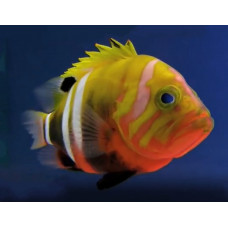Latin name
Cephalopholis igarashiensis
Other name
Neptune grouper, goldbar grouper, Japanese cod.
Identification
The garish hind has an elongated, massive body, somewhat compressed at the sides and covered on the sides with ctenoid scales. The height of the body exceeds the length of the head. Body height is 2.0-2.4 times the standard body length (in individuals 13 to 29 cm long). Head length is 2.3 to 2.5 times the standard body length. The upper profile of the head is straight or slightly concave. The interorbital space is flat. Occiput clearly convex. Upper margin of gill cover strongly convex. Upper jaw without scales, the tip of which extends to a vertical line passing through the posterior margin of the eye; there is a protuberance at the posterior lower corner. There are 8-9 gill stamens on the upper part of the first gill arch and 16-17 gill stamens on the lower part. There are 101-117 rows of scales along the lateral line, with no additional scales on the sides of the body.
Features of fish fins
The dorsal fin has 9 hard and 14 soft rays; the membranes between the hard rays are truncated. The anal fin has 3 hard and 9 soft rays. Pectoral fins have 18-19 soft rays. The pelvic fins are shorter than the pectoral fins, their ends reaching to or behind the anus. The height of the tail fluke is equal to or slightly greater than its length. The caudal fin is rounded. The lateral line with 60-65 scales forms an arc above the pectoral fins.
Fish colouring
Head, body and fins are reddish-orange. There are 7 lemon yellow stripes along the dorsal part of the body that merge into the dorsal fin. Three broad yellow stripes diverge from the eyes. Juveniles are yellowish with a large black spot on the dorsal fin, pelvic fins and the ends of the membranes of the barb of the dorsal fin are blackish.
Distribution
Widespread in tropical and subtropical waters of the western Pacific Ocean from southern Japan to Fiji and French Polynesia, including Taiwan, the Philippines and Tahiti. In the eastern Indian Ocean, they are found off the coast of northwest Australia (Rowley Reefs).
Habitat
Marine benthopelagic fish. They inhabit steep reef slopes, submerged highlands and coastal banks at depths of 64 to 250 metres.
Size
The maximum body length of the Garish Hind is 43 cm, but is more commonly 25 cm. Maximum life expectancy is over 40 years.
Behavior
A rare deep water species. Does not migrate.
Food and feeding habits
They feed on small fish and crustaceans.
Reproduction
They produce large numbers of eggs and their larvae are planktonic, usually at the mercy of ocean currents until they are ready to settle into an adult population.
Fishing
Subsistence fisheries. This fish species has no commercial value.
Relationship with a person
Harmless.
| Classification | |
| Phylum | Chordata |
| Class | Actinopterygii |
| Squad | Perciformes |
| Family | Serranidae |
| Genus | Cephalopholis |
| Species | C. igarashiensis |
| Features | |
| Conservation status | Least Concern |
| Habitat | Pelagic |
| Life span, years | 40 |
| Maximum body weight, kg | No information |
| Maximum length, cm | 43 |
| Sailing speed, m/s | No information |
| Threat to people | Not edible |
| Way of eating | Predator |
Garish hind
Tags: garish hind


